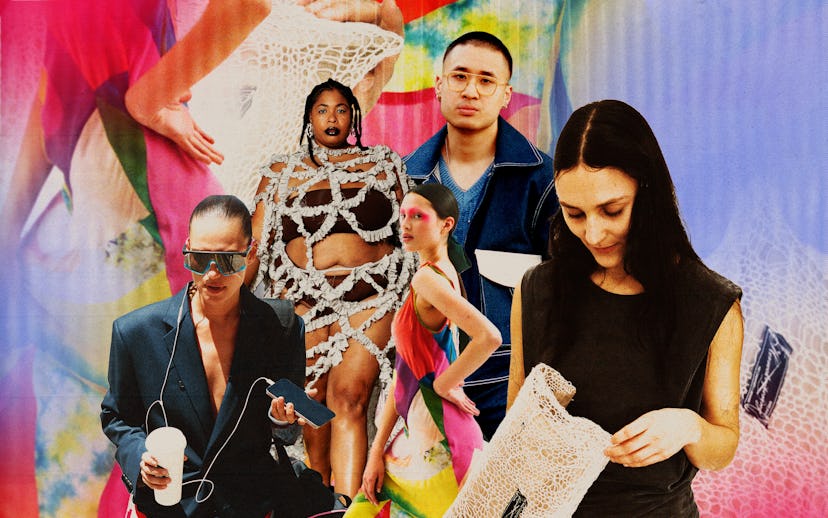
Fashion
5 Sustainable Fashion Designers You Need To Know
Turning deadstock and scraps into swingy denim co-ords and tie-dye gowns.
Fashion might not be the most environmentally friendly industry, but for a new guard of designers, the problems associated with manufacturing clothes pose an exciting challenge met with innovation and experimentation. Below, we’re featuring five designers who are reusing materials and crafting them into something entirely new, including very handsome suiting, tie-dye summer dresses, and structured workwear jackets that reflect their maker’s interpretation of the American dream. Keep scrolling to see the faces of fashion’s sustainable future.
Sam Finger
New York-based designer Sam Finger is already on the Council of Fashion Designers of America (CFDA) fashion calendar, just two seasons after starting his vintage-inspired brand. Finger only uses organic, upcycled, and ethically produced fabrics to create his sexy dresses and workwear-infused coordinating sets that fit right into what the downtown set is wearing. His Spring/Summer 2024 collection, titled “Heat Wave,” expanded on his genderless offerings with some of the most diverse casting of the week — and a salient message to boot: “the social impacts of how we dress in today’s dystopian era of global warming, culture wars, and the rise of artificial intelligence," Finger said in a news release. If his placements on Julia Fox are any indication, he’s leaning full force into getting his real clothes onto real bodies.
Ian Allen Greer
Ian Allen Greer not only craftily reworks preexisting clothes, but he’s also a master dyer who only uses organic materials to create pigment for his collections. He lives and works in New York, where he sources dye from onion skins and avocado pits collected from local markets and restaurants, and even flowers from his own backyard, Greer tells NYLON. It’s a tedious process, but one he says he believes can “set the industry standard for responsible clothing production domestically.” He was the first designer chosen by TheRealReal to participate in its “Realcycle” program, which challenges fashion makers to create collections out of otherwise unwearable clothes. The resulting capsule saw upcycled button-down shirts and tiered sundresses tie-dyed in yellows, greens, and blues that capture the organic color palette of nature.
Bettter
Bettter is a scientific restructuring of what fashion production can look like. London-based founder Julie Pelipas uses algorithms to measure the clothing she creates out of deadstock fabrics to get the exact size needed for customers, ensuring there’s zero waste. It doesn’t hurt that the end result is as fashionable as anything on the designer floor at Bergdorf’s: roomy, minimalist blazers; floor-grazing denim pants; and relaxed trousers. The “traditional” fashion world recognized something special in Pelipas’ bold framework, and she won the Karl Lagerfeld Prize at the esteemed 2023 LVMH fashion awards. The brand’s streetwear-meets-tennis collab with Fila is further proof that sustainability and high fashion can go hand in hand.
C. Patricio
Dallas-based designer Crespatrick de los Reyes stumbled upon the framework of his brand while working in Los Angeles for a denim brand. When jeans are made, the factories do “wash tests” of a few yards of the fabric to see how much it will shrink when made into jeans, and de los Reyes started stockpiling the scraps to use for what would become his own brand. Not only was this process low cost, but he says it made creating something new feel worthwhile because it didn’t create more demand for what is already known as an environmentally inefficient fabric. It also allowed for semi-couture one-offs, with every workwear jacket and oversized jean he’s created since 2019 varying slightly. “Being an American sustainable brand in 2024 feels like the ‘American dream,’” he tells NYLON. “Building something out of nothing in America is no easy feat. Sustainable fashion has opened a lower barrier of entry for designers like me to start their own business.”
Mfpen
Founded in 2015, the Danish brand embraces the country’s sustainable ethos as a daily practice. It stems from its Responsible Hierarchy, which details its fabric-sourcing preferences from most sustainable (upcycled/deadstock fabrics) to least (new organic cotton). A majority of the materials it finds come from Italian mills that discard overproduced textiles, which designer Sigurd Bank reworks into Scandi-dad menswear staples like office trousers, paper-thin trench coats, and casual button-down shirts in stripes and plaids. The brand just expanded into womenswear for fall 2023, so women needn’t feel left behind — although the roomy fits and neutral fabrics can easily translate across genders.